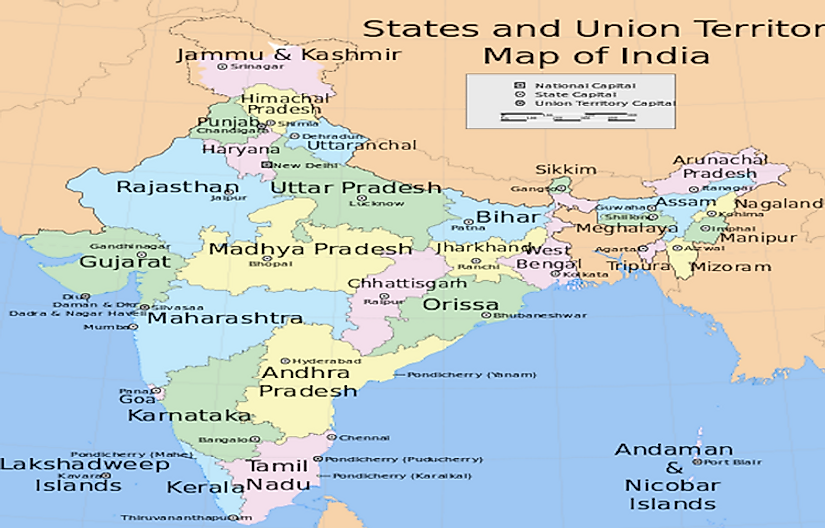State Capitals Of India

The Vast Country Of India
India is a South Asian country with a population of over 1.2 billion. It has a peninsular coastline with beaches on the Indian Ocean, Bay of Bengal, and the Arabian Sea. From 1757 to 1858, the region was under the control of the East India Company. In 1858, Queen Victoria took control of the company after the Indian Rebellion of 1857 and the British Raj ruled the area until 1947. With its independence in 1947 came its division into India and Pakistan.
Formation Of The India States
The original states were defined by following previous, British territories and provinces. This was changed in 1956 with the State Reorganization Act which separated states based on the majority language spoken within the region. New states have been added through the year 2011. Today, India has 29 states and 7 union territories. This article takes a look at some of the most influential state capitals of India.
New Delhi
New Delhi is the capital of the National Capital Territory of Delhi and has a population of approximately 302,363 although the entire territory has a population of around 25 million. This city has a long history of being an important financial and government center that dates back to before the Mughal Empire of 1649 to 1857. It was not considered the capital of the country, however, until King George V and Queen Mary delegated it as such in 1911. Today, New Delhi is one of the most important economic centers in the country. In addition to hosting one of the largest commercial and financial areas, this city also relies on the government sector to provide employment. In 2014, the World Health Organization reported that New Delhi had the worst air quality in the world. Since then, the government has implemented an alternative car-use schedule and new regulations for the public transportation sector.
Mumbai
Mumbai is the capital of the state of Maharashtra and has a population of 18.4 million. Known as Bombay until 1955, this city is located on the western coast of India. It has a diverse population that speaks 16 different languages, the most common of these are: Marathi, Hindi, Gujarati, and English. The economy here relies on factories, with roughly 10% of India’s factory employment located in Mumbai and because it is a port city, it also provides about 60% of customs duty collections nationwide. Although there is economic opportunity in Mumbai, it is not enough for the large population living here. About 62% of the people live in informal slums where they experience high levels of unemployment, lack of access to healthcare and basic utilities and poor public education.
Kolkata
Kolkata is the capital of West Bengal and has a population of 14.1 million (including the suburbs). Researchers have found evidence of human settlements around this area that date back to over 2,000 years. In 1772, it hosted the East India Company headquarters which took control of the city by 1793. In 1911, the British rulers took the capital to New Delhi. It is now considered the cultural capital of the country and is largely populated by Bengali Hindus. Bengali is the official language, although English and Hindi are also spoken. Although this state capital of India is the financial, military, and commercial center for eastern India, roughly 40% of the population works in the informal economic sector. About one-third of the people living here experience extreme poverty and live in undeveloped and underdeveloped slums.
Bengaluru
Bengaluru, also known as Bangalore, is the capital of the state of Karnataka. Approximately 8.42 million people live within the city limits. It has the second fastest-growing economy in the country which has enjoyed a 10.3% growth rate. The main industry in this state capital of India is information technology (IT), producing approximately 33% of the country’s IT exports. The growing economy has contributed to increased real estate prices which have pushed small businesses and lower-income families out of the city and into the marginal areas. Roughly 10% of the people here live in the slums, a significant amount, though lower than the percentage in other major cities.
State Capitals Of India
| Rank | State/Union Territory | Administrative capitals |
|---|---|---|
| 1 | Andaman and Nicobar Islands | Port Blair |
| 2 | Andhra Pradesh | Hyderabad |
| 3 | Arunachal Pradesh | Itanagar |
| 4 | Assam | Dispur |
| 5 | Bihar | Patna |
| 6 | Chandigarh | Chandigarh |
| 7 | Chhattisgarh | Raipur |
| 8 | Dadra and Nagar Haveli | Silvassa |
| 9 | Daman and Diu | Daman |
| 10 | National Capital Territory of Delhi | New Delhi |
| 11 | Goa | Panaji |
| 12 | Gujarat | Gandhinagar |
| 13 | Haryana | Chandigarh |
| 14 | Himachal Pradesh | Shimla |
| 15 | Jammu and Kashmir | Srinagar (Summer) Jammu (Winter) |
| 16 | Jharkhand | Ranchi |
| 17 | Karnataka | Bengaluru |
| 18 | Kerala | Thiruvananthapuram |
| 19 | Lakshadweep | Kavaratti |
| 20 | Madhya Pradesh | Bhopal |
| 21 | Maharashtra | Mumbai |
| 22 | Manipur | Imphal |
| 23 | Meghalaya | Shillong |
| 24 | Mizoram | Aizawl |
| 25 | Nagaland | Kohima |
| 26 | Odisha | Bhubaneswar |
| 27 | Puducherry | Puducherry |
| 28 | Punjab | Chandigarh |
| 29 | Rajasthan | Jaipur |
| 30 | Sikkim | Gangtok |
| 31 | Tamil Nadu | Chennai |
| 32 | Telangana | Hyderabad |
| 33 | Tripura | Agartala |
| 34 | Uttar Pradesh | Lucknow |
| 35 | Uttarakhand | Dehradun |
| 36 | West Bengal | Kolkata |







